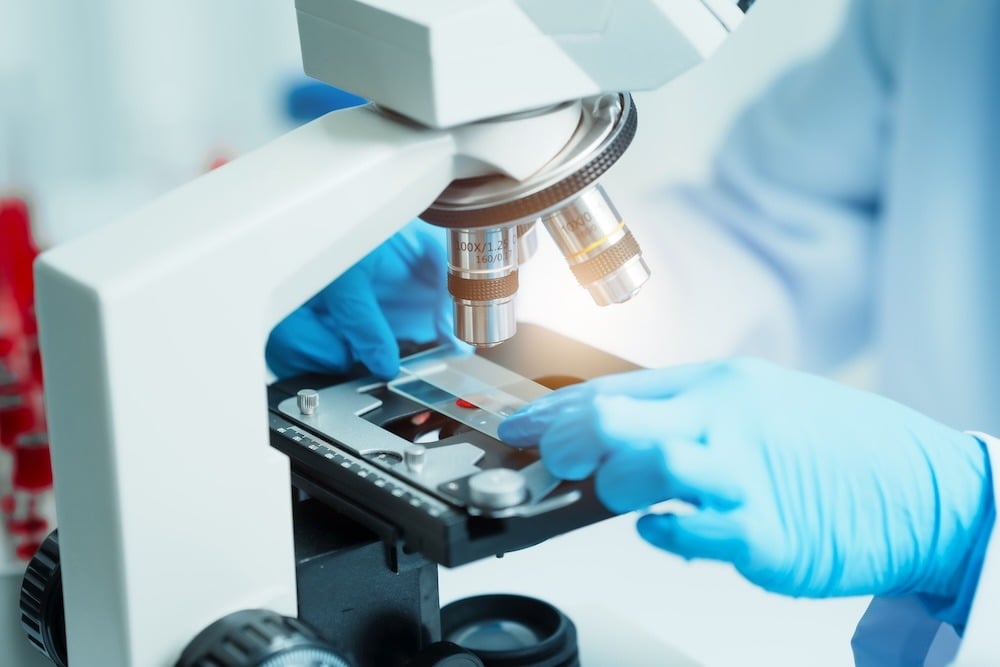Understanding the Difference Between Acute and Chronic Leukemia
5 min read

Leukemia is a cancer that starts in the bone marrow, affecting healthy blood cell development. There are different types of leukemia, classified by the type of cell they come from and how quickly the cancer cells grow.
The treatments available are based on both of these categories. Let’s examine acute (fast-growing) and chronic (slow-growing) leukemias to see what happens after a diagnosis.
How Do Acute and Chronic Leukemia Differ?
The terms "acute" and "chronic" describe how quickly leukemia may progress.
- Acute leukemia occurs when the bone marrow quickly develops too many immature blood cells rather than mature cells. While anyone can develop acute leukemia, it is more common in children, teens, and young adults. Acute leukemia is fast-growing and aggressive, meaning that symptoms often arise shortly after the condition develops and are more pronounced. Immediate treatment is required in cases of acute leukemia to achieve the best possible outcome.
- Chronic leukemia cells are more mature than acute leukemia cells but are still abnormal. By not developing fully, they fail to function properly. Chronic leukemia progresses slowly. As a result, it may take months or even years for symptoms to appear. Most patients with chronic leukemia are diagnosed incidentally during routine medical testing or because a symptom is identified that is assumed to be related to another condition. Generally, older adults are more affected by chronic leukemia than younger individuals.
Subtypes of Leukemia
When diagnosing leukemia, doctors also consider the specific type of blood cell from which the cancer has developed. There are two primary types of cells from where leukemia can develop:
- Lymphoid cells produce lymphocytes, a type of white blood cell in the bone marrow.
- Myeloid cells produce red blood cells, platelets, and other types of white blood cells that are not lymphocytes.
Based on the responsible cell type, most leukemias are categorized into four main subtypes:
- Acute lymphoblastic leukemia (ALL): This type affects lymphocytes, causing them to grow rapidly. Treatment depends on whether the leukemia is based on T-cells or B-cells.
- Chronic lymphocytic leukemia (CLL): CLL affects lymphoid cells and typically develops slowly. It is the most common subtype of leukemia.
- Acute myeloid leukemia (AML): This subtype impacts the blood cells and the bone marrow. It is characterized by an overproduction of immature white blood cells that become cancerous.
- Chronic myeloid leukemia (CML): CML is caused by a genetic mutation involving the Philadelphia chromosome. This mutation results in the uncontrolled growth of immature white blood cells, which crowd out other essential blood cells.
Related Reading: How Acute Myeloid Leukemia (AML) is Different from Other Blood Cancers
How Symptoms Differ Between Acute and Chronic Leukemia
Typically, acute leukemia symptoms appear early, while symptoms associated with chronic leukemias may not appear until the condition is far advanced.
Acute Leukemia Symptoms
Certain symptoms that are more specific to Acute Lymphoblastic Leukemia (ALL) and Acute Myeloid Leukemia (AML), often resulting from low blood cell or platelet counts, include:
- Frequent infections (due to a lower number of healthy white blood cells)
- Easy bruising
- Headaches
- Bone and joint pain
- Bleeding gums
- Pale complexion (due to a lower number of healthy red blood cells)
- Frequent or severe nosebleeds
- Slow-healing wounds
- Prolonged bleeding from minor cuts
It is important to see your doctor for an examination if you experience any of the above symptoms.
General Leukemia Symptoms
Some general symptoms to watch for, regardless of the leukemia type, include:
- Fatigue
- Fever
- Night sweats (not related to menopause)
- Unexplained weight loss
- Loss of appetite
- Fullness or swelling in the abdomen or below the ribs, which may be due to an enlarged spleen or liver
- Swollen lymph nodes, which appear as painless lumps often located in areas such as the neck, underarms, and groin
- Shortness of breath
- Lightheadedness or dizziness
If you experience any of these for more than a week or so, contact your doctor for an evaluation.
Related Reading: Common Symptoms of Leukemia
Are Acute and Chronic Leukemias Treated the Same Way?
Several different treatment options are available for both acute and chronic leukemia. Your hematologist, who is most likely also your oncologist, will determine the best timing for your treatment based on your specific type of leukemia.
Treating Acute Leukemia
The treatment for acute leukemia is divided into three phases: induction, consolidation, and maintenance.
- Induction aims to achieve full remission from leukemia. This phase involves treatment with chemotherapy drugs and, in some cases, a stem cell transplant. Individuals with leukemia that has the Philadelphia chromosome may also receive targeted therapy. Generally, the induction phase lasts about a month.
- Consolidation, also called intensification, involves giving more chemotherapy to kill any remaining cancer cells. It starts after your leukemia has successfully gone into remission. Depending on your specific situation, immunotherapy, targeted therapy, and stem cell transplants may also be included in this phase of the treatment plan.
- Maintenance therapy is designed to prevent the disease from recurring after the initial two phases of treatment. Typically, this phase uses lower doses of oral chemotherapy drugs, which will combat any cancer cells that reappear.
The entire process of treating acute leukemia typically takes about two years.
Treating Chronic Leukemia
If you were diagnosed with slow-growing chronic lymphocytic leukemia (CLL), your blood cancer specialist may recommend a watchful waiting approach until the cancer progresses to a point where treatment becomes necessary.
Unfortunately, a watchful waiting approach is not recommended for chronic myeloid leukemia (CML). Many patients receive tyrosine kinase inhibitors (TKIs), a type of targeted therapy that specifically targets substances on cancer cells while minimizing damage to normal, healthy cells. This medicine could be taken to control the leukemia for the rest of the patient’s life. Sometimes, targeted therapy may be combined with other treatments like immunotherapy and chemotherapy.
Is Radiation Therapy Used to Treat Leukemia?
Typically, radiation therapy is not a standard treatment for leukemia. However, it can be used as palliative care to alleviate pain and manage symptoms caused by enlarged lymph nodes, spleen, or other organs that may be blocking or pressing on nearby body parts, such as the kidneys or throat.
Advanced Leukemia Care in Colorado
If you have recently been diagnosed with acute or chronic leukemia, Rocky Mountain Cancer Centers can help you explore all your treatment options. Our expert hematologic oncologists will explain your diagnosis clearly and discuss treatment options tailored to your age and preferences.
Hematologic oncologists are available at RMCC locations in Denver, Boulder, Colorado Springs, and surrounding areas. Request an appointment at one of our locations to learn more about your treatment options and next steps.
